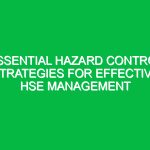Understanding PPE: What Does PPE Mean in the HSE Context?
Personal Protective Equipment (PPE) is a critical component in the fields of health, safety, and Environment (HSE). But what does PPE mean exactly? In simple terms, PPE refers to any equipment worn to minimize exposure to Hazards that can cause serious workplace injuries and illnesses. This includes a wide range of protective gear, such as helmets, gloves, eye protection, high-visibility clothing, and respiratory protection. Understanding the significance of PPE in the HSE domain is vital for ensuring Safety in various industries, from healthcare to construction.
In the HSE context, PPE serves as the last line of defense against Hazards when other Control Measures, such as engineering controls or administrative changes, are not feasible. The importance of PPE cannot be overemphasized; it helps safeguard workers from potential dangers that exist in their work environments, contributing not only to individual Safety but also to overall organizational health.
The Components of PPE
To grasp the concept of PPE fully, it’s essential to break down its various components and the specific roles they play in protecting workers.
Types of PPE
- Head Protection: Hard hats protect against head injuries from falling objects and Electrical Hazards.
- Eye Protection: Safety Goggles and face shields prevent eye injuries from chemicals, flying debris, or harmful radiation.
- Hearing Protection: Earplugs and earmuffs help mitigate noise-induced hearing loss in high-noise environments.
- Respiratory Protection: Masks and respirators protect workers from inhaling harmful substances, such as dust, fumes, and gases.
- Hand Protection: Gloves are essential for preventing cuts, abrasions, burns, and exposure to chemicals.
- Foot Protection: Safety boots with steel toes shield feet from heavy objects and punctures.
- Body Protection: High-visibility clothing ensures that workers are seen in low-light conditions, while chemical suits provide a barrier against hazardous substances.
Each type of PPE is designed for specific hazards, making it imperative for employers and employees alike to assess their particular risks and select appropriate gear.
The Importance of Proper Use and Maintenance
Having the right PPE is crucial, but so is using it correctly. Employees must be trained not only in how to wear PPE but also in recognizing when it is necessary. Regular maintenance is equally important; worn-out or damaged equipment can fail to provide adequate protection.
For example, a construction worker might wear a hard hat, but if it’s cracked or compromised, it won’t offer the necessary protection. An anecdote from the construction industry highlights this: a worker failed to replace his damaged helmet, resulting in a severe head injury when a tool fell from above. This incident underscores the importance of proper PPE use and maintenance.
Benefits of Effective PPE Use
Utilizing PPE effectively leads to numerous Benefits, both for employees and organizations.
Health and Safety
The primary benefit is the enhancement of worker safety. By minimizing exposure to hazards, PPE significantly reduces the risk of occupational injuries and illnesses. In sectors like healthcare, the use of PPE has been vital in protecting professionals from infectious diseases, especially during the COVID-19 pandemic.
Regulatory Compliance
Adhering to PPE Regulations ensures compliance with government laws and industry Standards, which can prevent legal repercussions and financial penalties. For instance, organizations that fail to provide adequate PPE might face sanctions from regulatory bodies such as OSHA (Occupational Safety and Health Administration) in the United States.
Improved Productivity
When workers feel safe, they can focus better on their tasks. A safe work environment fosters higher morale and productivity. For instance, a factory that provides quality PPE and encourages its use often sees fewer accidents and higher output.
Potential Hazards and Risks
While PPE is essential, it is not without its challenges. It is crucial to recognize potential hazards associated with its improper use.
Inadequate Training
Workers may lack proper training on how to wear and maintain PPE. This can lead to misuse or neglect, reducing its effectiveness. Regular training sessions should be conducted to ensure that all employees understand the importance of PPE and how to use it effectively.
Overreliance on PPE
Some workers may become overly reliant on PPE, believing it to be a complete solution to safety. This mindset can lead to complacency regarding other Safety Measures, such as following proper protocols or maintaining equipment. Each worker must understand that PPE is a supplementary measure, not a substitute for safe work practices.
Physical Discomfort
Wearing PPE can sometimes be uncomfortable, leading to workers removing it inappropriately. For example, a healthcare worker might find a mask too hot to wear during long shifts, risking exposure to contaminants. Employers should select PPE that balances protection with comfort to encourage compliance.
Best Practices for PPE Implementation
To maximize the effectiveness of PPE, several Best Practices should be followed:
Conduct Risk Assessments
Before selecting PPE, conduct thorough risk assessments to identify potential hazards in the workplace. This process helps determine which types of PPE are necessary for specific tasks and environments.
Involve Employees in the Process
Engaging employees in the selection of PPE can lead to better acceptance and adherence. Workers are more likely to use equipment they helped choose, ensuring it meets their practical needs.
Regular Training and Refreshers
Implement ongoing training programs that not only educate employees about the importance of PPE but also refresh their knowledge periodically. This ensures that safety remains a priority and that employees are aware of any new hazards or PPE updates.
PPE Regulations and Standards
Understanding the regulatory landscape surrounding PPE is crucial for compliance.
osha Regulations
In the United States, OSHA sets forth regulations regarding PPE under the Occupational Safety and Health Act. These regulations mandate that employers assess workplace hazards and provide appropriate PPE to employees at no cost. Failure to comply can result in fines and legal action.
ANSI Standards
The American National Standards Institute (ANSI) also plays a role in establishing guidelines for PPE. ANSI standards provide specifications for various types of protective gear, ensuring that equipment meets minimum safety requirements.
International Standards
Globally, standards like ISO (International Organization for Standardization) help ensure consistent quality and safety in PPE. Understanding these standards aids organizations in maintaining compliance and protecting their workforce.
Conclusion
In conclusion, understanding what PPE means in the context of health, safety, and environment is vital for promoting Workplace Safety. By recognizing the importance of PPE, its components, the benefits of proper use, and the potential hazards associated with it, organizations can create safer work environments. Furthermore, adhering to regulations and implementing Best Practices ensures that employees are equipped to handle risks effectively.
As we navigate an increasingly hazardous world, the significance of PPE will only grow. It is essential for both employers and employees to remain vigilant, committed to safety, and proactive in using and maintaining Personal Protective Equipment. By doing so, we can contribute to a culture of health, safety, and environmental Sustainability in our workplaces.


